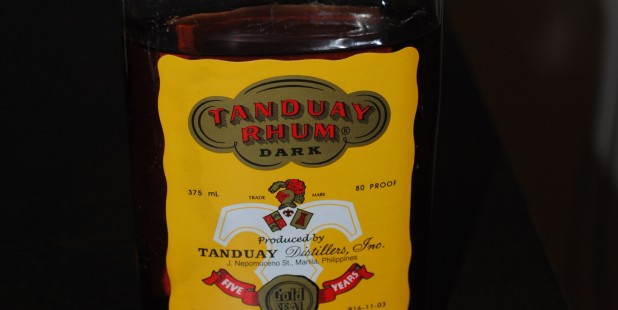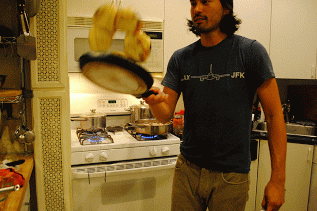Chef Norman Dalager (Masarap Supper Club) with his take on the current Filipino food movement, his inspiration for cooking, and an awesome thing which he calls the “Shady Brunch.”
“Yo, I’m up here,” he called from above the staircase.
We were at Chef Norman Dalager’s pad, running late for an interview session with the man in his own kitchen. We had thought that the best setting to speak with Norman was in his own element where he creates great and delicious things. But, one thing I learned from Chef Norman, he doesn’t do things half-assed.
Dalager, for all intents and purposes, is a “Champion of the People” (as coincidentally, he was voted as “People’s Favorite” from the recent Pinoy chef throwdown, Salu-Salo). He is a candid and welcoming person with a genuine love for food, and it so happens that he is also an incredibly talented cook.
He is also a kindred spirit among those conscious of Filipino food and its representation. Norman has been careful to maintain a healthy respect for tradition while displaying his skills and creativity in presenting a retelling of the classics. So I was pleasantly shocked when he forwarded an invite he just sent out to his friends.
I guess he figured, he might as well throw a dinner party and make things more interesting.
—
You’re invited to a special mid-week edition of the Shady Brunch.
Please arrive to (__somewhere in the Upper West___) for ‘brunch’ at 8pm.
You must bring a female guest.
This is a media event, so dress proudly and don’t be late.
No, this has nothing to do with Banksy.
Chef Normando
—
As we made our way to his door, we were greeted by a tall, smiling figure in this cool LAX x JFK shirt, and half an onion in hand.
I was already awed by his resume – a Journalism grad from Truman State University, which led him to a career in print media with the Boston Globe and the New York Times. He then heads to MTV, and now with Bravo to work on television (with an Emmy win by his team working on Top Chef’s “Last Chance Kitchen”).
And, somehow along the way, he has also managed to become a chef and start a supper club that features Filipino fare.
“Hey there,” he motioned. “I’m Norman.” He was prepping for dinner – a creative four-course meal inspired by Filipino classics. It would be easily one of the most memorable dinners I have had in a long time.
First things first, though: A shot of this iconic Pinoy rum.
(Kids, you remember the commercials from back home, right?)
As the night would ensue, Chef Norman would break out the said smorgasbord of awesome dishes, straight out of the dome. It was like a culinary freestyle, with hints at both familiar and new flavor profiles.
He went back to his mirepoix. “One of the reasons why I’m so happy to have you guys over tonight was because, this is the movement… Just to see Filipinos being aware of like, ‘Hey, let’s help other Filipinos…’ instead of the usual mentality of, this Filipino is better than me, I gotta step it up… I understand, like, when your neighbor puts up Christmas lights, the other wants to put up more for his house. So I understand the competitiveness Filipinos have, and it tends to be more discouraging instead of encouraging (each other)…
“Here (in New York), it’s not like that. Maharlika, Jeepney, all the chefs here, they kinda saw what I was doing and they were like, ‘Hey, we want to include you. We can totally see you and what you can offer, you’re with us now.’ So for me, they’re the wind beneath my wings. And the reason it’s so important to me is because I’m just trying to do this to hang out and cook, you know, and chill. And they appreciate that, they know that I’m into the food and, I’m not trying to sabotage business or cannibalize their market, I understand it’s a livelihood. So these guys like Ron and King and Miguel, when I see those guys out there, they just take the energy. They’ve reached out and said, ‘We do this for a living, and you do this because you enjoy it,’ and to them, they respect that…
“And they know it’s sincere because they can’t get rid of you. ‘Norman’s here again, oh shit!’ (Laughs) And, you know, I challenge them. I made a dinuguan meatball, for instance, for one of the fundraisers… I ground up the pork, I made a meatblood gravy, put it in a pan de sal slider, and vegetarians (were interested)! It’s like, you know when people look at dinuguan and they go, ugh, what is that? But with that slider, word was getting around, and even the vegetarians would go and say ‘I’ll try it.’ Vegetarians, dude! This girl who hadn’t eaten meat for six years ate two of them.”
“…Filipino food is not just something you can eat at home… it’s something you can be proud of. You can take it and turn it into something that other cultures around the world can recognize as respectable… That is the challenge now. That’s the challenge in New York City – well, not so much a challenge, but that’s essentially what has happened here.”
Chef Norman’s kitchen was starting to smell really good – it brought you back like you were in your lola’s kitchen. There was an enthusiasm in his voice, a sense of fervent consciousness that he is aware of the respect Filipino food needs and deserves.
“Moving this forward, right – the Philippine culture, it’s very traditional food-wise. Otherwise, we’re really just westernized. Pinoys wanna eat Kentucky Fried Chicken, pizza when they go out. They’re not looking for beef steak Tagalog, they can get that when they go home. So what ends up happening is that restaurants don’t evolve with the rest of the culture – music, movies, fashion, it’s all transformed in the past 30 years. Food has not, at all. Filipino food, specifically in Manila, has not. So the opportunity there is with people who understand that Filipino food is actually not just something you can eat at home… it’s something you can be proud of. You can take it and turn it into something that other cultures around the world can recognize as respectable…
“That is the challenge now. That’s the challenge in New York City – well, not so much a challenge, but that’s essentially what has happened here.”
I asked him, why do you think our food doesn’t necessarily have the challenges that other Asian food cultures have?
“Yeah, think about it, right? Think about Chinese food, the type you get down the street. It’s very popular but it’s not necessarily what you’d get from Beijing. The same with Thai food, which is also really amazing, like pad Thai or pad see ew. It’s like ‘mac and cheese,’ or pizza here. It’s not really Thai, but it’s a representation of it. I would say that Filipino food may eventually be Americanized, maybe not, maybe that’s what is happening now. But “commercialized” is a different thing. I don’t think you can commercialize Filipino food – I dunno, I just can’t conceive it. I can’t imagine going to a mall here or a food court eating pancit or okoy– it’s too unique, you know?”
Do you get any raised eyebrows when you pull a dish like okoy out? Not even a lot of Pinoys know about okoy, for example.
(Laughs) “Of course they dont, because it’s not even on the menus, which is why I decided to make that for the contest (Salu Salo). I’m the kind of guy that, when I raise eyebrows, for me that’s a great reaction. Especially in New York that when people raise their eyebrows, it’s to stop and smell the roses. It’s curiosity, which is why when there’s a Banksy piece thrown up, people stop, they observe and go ‘oh, what’s happening here?’ I kind of pride myself in getting people to look twice and ask questions.”
His guests were starting to arrive. Paul Miller and Elizabeth Oakley were the first to arrive, beer and wine in hand. They were two of tonight’s lucky diners and they would be joined by two other couples, Geovannie Conception with fiancé Jennifer Aviles, and Geoff Baszczuk with Camila Zapata. Geoff would also be the helpful aid of Chef Norman for the night.
#RIPHousewives
(From left to right: Elizabeth, Paul, Geoff, Camila, Geovannie, Jennifer and Chef Norman)
Norman hands a bowl of garlic to sous chef Geoff. “Shake that for about 20 seconds as hard as you can.”
It’s a neat little trick, he explains, so that the garlic is peeled without the natural oils coming out from as opposed to when you smash them.
Tonight on Chef Norm’s menu:
1) Fried brussel sprouts, mango, vegetarian beefsteak Tagalog.
2) Turkey menudo stew w/ sweet potato
3) Fried chicken adobo, house hot sauce, pan-de-sal french toast
4) Champorado chocolate rice pudding, brûléed evaporated milk, Kona coffee beans
Dinner was really brilliant. I personally found myself really, really impressed, because as someone who is familiar with the original forms of the dishes, Norman’s presentation was something that was all new to me at the same time.
The photo above, by the way, was a result of everyone having eaten their fill and needing to stretch their legs. And, Norman thought it might be funny to have everyone in a lineup.
Norman and I continued to talk about his beginnings, his outlook on food, his goals with Masarap Supper Club and the upspring of our culture, particularly through gastronomy.
—
Before anything, allow me to get the standard Liptonesque questions out of the way. Where were you born?
Born in the bay area, raised in SD, educated in MO and have spent significant time in Boston, Tampa and now NYC.
What did your parents, Norma and Gary do for a living?
Dad is a retired Navy technician who now works as an industrial maintenance mechanic. My mother is fully retire, formerly a QA engineer for electronics and food processing facilities.
What was it like to grow up with three sisters as siblings? (Are you the youngest?)
Being the youngest and only boy, I seem to get my way every time. That didn’t come without collateral damage in the form of extra chores, constant teasing, and infliction of a few scars that I still have to this day.
You’re a pretty versatile guy, with an impressive journalism background that included stints with the Boston Globe and the Times, and now a chef and working in television production – was this always the plan from when you were younger?
It would be really prolific to have planned this path from a very young age! Mostly when asked the age old “What do you wanna be when you grow up?” question, my answer was always to become a pro photographer. At the age of 10, I won a writing contest and the grand prize was a two-week all-expenses paid trip to Japan. I must have shot 25 rolls of film from that trip. That’s when I fell in love with the camera.
Is photography the main reason you got into journalism? What would be some of the best scenes you’ve shot?
Absolutely. Along with a BA in journalism, I actually have a minor in fine art photography. Most of my early work for the Globe was shooting and editing photo galleries for the Web site. Besides shooting life and culture of 1990s Tokyo, some of the standout assignments include Snowy Boston, the Nantucket Travel Guide, Bonnaroo Music Fest 2009, and the 2004 Red Sox Championship series.
You mentioned that you DJ as well – which artists would be on your playlist?
Lots of turn-of-the-century dance and hip hop. I feel like that was the era for party music. Most of the songs I introduce to my catalog now are minimal and tech house tracks from Scandinavian music labels.
How did your journey lead you to cooking?
I was lead by the desire to eat great food while lacking the financial means to afford going out to eat everyday. My mother (and sometimes my father) have always provided our family with sensational homecooked meals. One summer I asked her to teach me a few basic dishes and it took off from there. Now I’m at the point where I’m the one who plans and prepares the family holiday meals, which is a huge honor among the Dalager’s.
What kind of cuisine would you categorize yours to be in?
Definitely comfort food. I enjoy creating dishes from all cultures, be it Midwest BBQ, Filipino, traditional breakfast, or French refined. The key for me is to take ingredients that are fresh and in-season and create a meal that people will find inspiring and satisfying.
Who would you consider as your influences in gaining an appreciation for food, and the style of food that you make?
I gain inspiration from the meals I eat and people I feed. It’s very simple: If I find a great dish at a restaurant or party, I want to learn how to create it. And if I create a recipe that causes people react, I use that feedback to improve the creation.
What is your take on the current spike into mainstream consciousness that Filipino food is currently experiencing?
Restaurants and chefs in NYC are doing an incredible job introducing Filipino food to the scene while being inventive in order to draw interest for those of us who are already familiar with the traditional stuff. The success that I’ve witnessed with Jeepney, Maharlika, Pig n Khao, Lumpia Shack proves that the dining audience in this city want Filipino food to stay. The ultimate goal I find is to use this avenue to draw more global attention to the Philippines as both a incredible travel destination and a nation that struggles with third-world disasters.
Do you see certain/specific ways that our food can utilize to concretely define what “Filipino food” is?
Garlic – I feel as though we use garlic more that Italian chefs! Filipino food can easily be defined by the standard formula used by our Lola and Titas. Though the boundaries of what can be considered Filipino food are evolving and this creates a healthy discourse between generations in Filipino families.
Tell us about Masarap Supper Club. Who runs it with you?
Along with my friends Robert Kearns and Allister Kligensmit, Masarap is a monthly dining event where we host 15-25 people in a private residence for a 6-course meal with cocktail hour. The dinners are cleverly themed, and the menu is always one-of-a-kind.
You’ve been around with some of the now-instantly recognizable names in New York. Are we seeing the renaissance period of modern Filipino cuisine start right here in our own backyard?
Growing up on the west coast, in my childhood I was spoiled with the seemingly endless supply of Filipino restaurants. The west coast might have us in numbers, but NYC is definitely leading the charge in refining the presentation and technique (especially with cocktails).
—
It was midnight. The Champorado was ready to serve, and one souffle cup was made special for Geo, who was celebrating his birthday.
It was a great night.
—
To all aspiring journalists, chefs and DJs out there, what would be your advice for them?
My first piece of advice is to not be afraid to donate your time in order to get an chance to perform, write or cook for a big audience. People will recognize your talent, passion, and sincere desire to create a quality product, which will likely lead to many business opportunities. Second, you must be INVENTIVE to stand out. Each time I hear that one of my ideas is “crazy” I’m convinced that it’s innovative, so don’t let that word discourage you.
[nggallery id=84]
Chef Norman Dalager is the Head Chef and Founder of Masarap NYC. For more information, check them out online:
Chef Norman on Twitter – @rareformnorm
[Photos and video by Jose Mercado]















